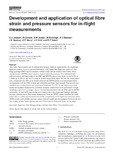JavaScript is disabled for your browser. Some features of this site may not work without it.
| dc.contributor.author | Lawson, Nicholas J. | |
| dc.contributor.author | Correia, Ricardo N. | |
| dc.contributor.author | James, Stephen W. | |
| dc.contributor.author | Partridge, Matthew | |
| dc.contributor.author | Staines, Stephen E. | |
| dc.contributor.author | Gautrey, James E. | |
| dc.contributor.author | Garry, Kevin | |
| dc.contributor.author | Holt, Jennifer C. | |
| dc.contributor.author | Tatam, Ralph P. | |
| dc.date.accessioned | 2016-09-16T13:52:29Z | |
| dc.date.available | 2016-09-16T13:52:29Z | |
| dc.date.issued | 2016-09-16 | |
| dc.identifier.citation | Lawson NJ, Correia R, James SW, et al., (2016) Development and application of optical fibre strain and pressure sensors for in-flight measurements. Measurement Science and Technology, Volume 27, Issue 10, Article number 104001 | en_UK |
| dc.identifier.issn | 0957-0233 | |
| dc.identifier.uri | http://dx.doi.org/10.1088/0957-0233/27/10/104001 | |
| dc.identifier.uri | https://dspace.lib.cranfield.ac.uk/handle/1826/10540 | |
| dc.description.abstract | Fibre optic based sensors are becoming increasingly viable as replacements for traditional flight test sensors. Here we present laboratory, wind tunnel and flight test results of fibre Bragg gratings (FBG) used to measure surface strain and an extrinsic fibre Fabry–Perot interferometric (EFFPI) sensor used to measure unsteady pressure. The calibrated full scale resolution and bandwidth of the FBG and EFFPI sensors were shown to be 0.29% at 2.5 kHz up to 600 με and 0.15% at up to 10 kHz respectively up to 400 Pa. The wind tunnel tests, completed on a 30% scale model, allowed the EFFPI sensor to be developed before incorporation with the FBG system into a Bulldog aerobatic light aircraft. The aircraft was modified and certified based on Certification Standards 23 (CS-23) and flight tested with steady and dynamic manoeuvres. Aerobatic dynamic manoeuvres were performed in flight including a spin over a g-range −1g to +4g and demonstrated both the FBG and the EFFPI instruments to have sufficient resolution to analyse the wing strain and fuselage unsteady pressure characteristics. The steady manoeuvres from the EFFPI sensor matched the wind tunnel data to within experimental error while comparisons of the flight test and wind tunnel EFFPI results with a Kulite pressure sensor showed significant discrepancies between the two sets of data, greater than experimental error. This issue is discussed further in the paper. | en_UK |
| dc.language.iso | en | en_UK |
| dc.publisher | IOP Publishing | en_UK |
| dc.rights | Attribution 3.0 International | |
| dc.rights.uri | http://creativecommons.org/licenses/by/3.0/ | |
| dc.subject | flight test | en_UK |
| dc.subject | fibre Bragg grating | en_UK |
| dc.subject | extrinsic fibre Fabry-Perot interferometer | en_UK |
| dc.title | Development and application of optical fibre strain and pressure sensors for in-flight measurements | en_UK |
| dc.type | Article | en_UK |
| dc.identifier.cris | 15190914 |
Files in this item
This item appears in the following Collection(s)
-
Staff publications (SATM) [4360]

